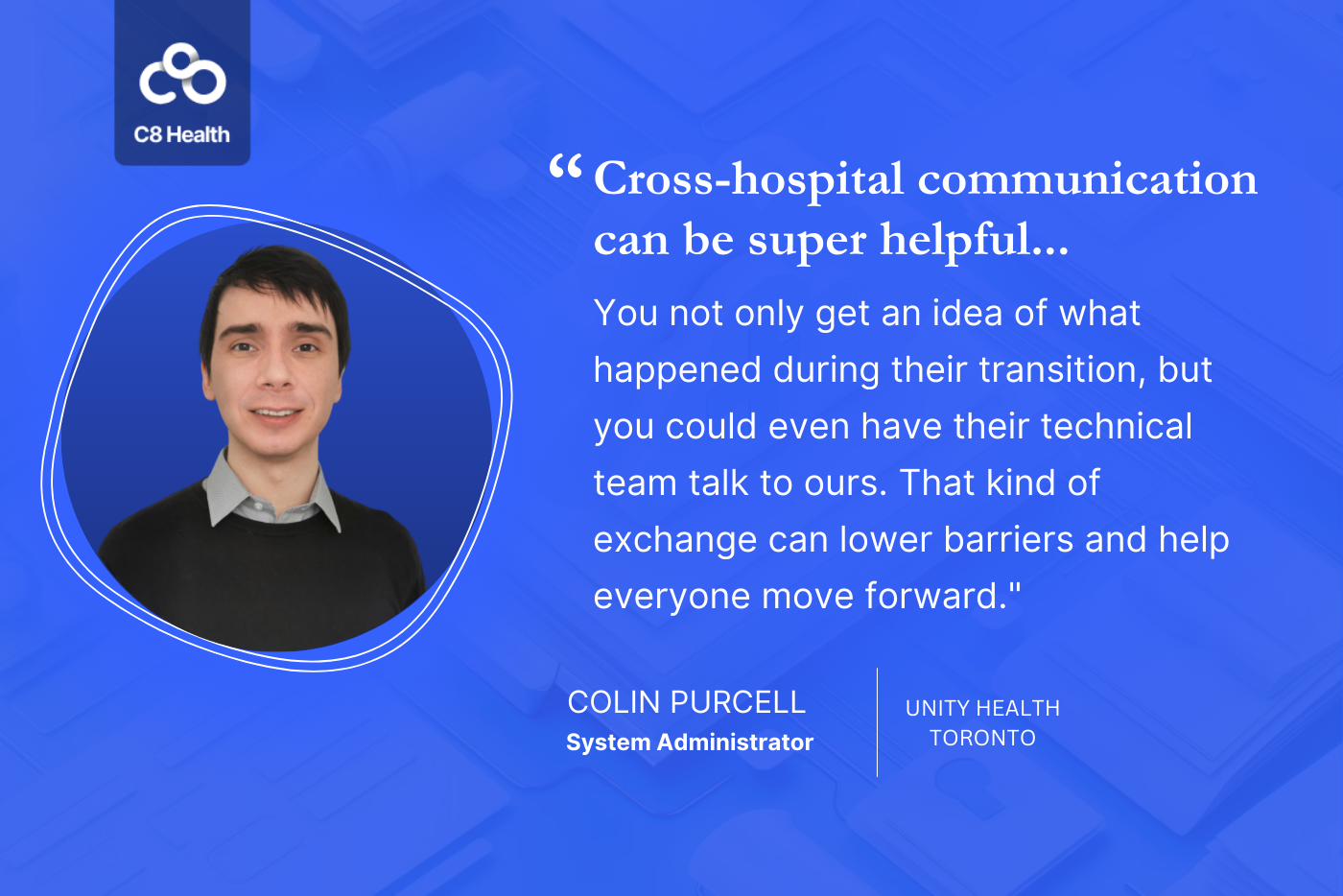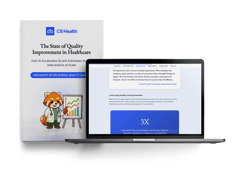
How Clinicians & IT Can Work Together in the Age of AI: Tips From a Systems Administrator
Disclaimer: The opinions expressed in this article are those of the individual and do not necessarily reflect those of Unity Health Toronto.
Artificial intelligence is set to redefine many industries, but few as dramatically as healthcare. Forecasts place the value of AI in healthcare at around $188 billion by 2030, which is why hospitals like Unity Health Toronto have formed dedicated teams to assess, design, and scale AI tool adoption.
The roughly 30 members of Unity Health’s Data Science and Advanced Analytics team, created just before the COVID-19 pandemic, explore innovative AI applications and align them with the hospital’s priorities. We sat down with Colin Purcell, a system administrator, to learn more about its unique role and how clinicians can partner with IT teams to facilitate the smooth and productive adoption of AI solutions.
Our conversation focussed primarily on ways clinicians, often the drivers of tool adoption, can align their interests with those of IT and other support staff to minimize friction and realize powerful benefits from AI-powered solutions. According to Purcell, it starts with understanding the hospital’s macro-level goals.
Key Takeaways
- Align proposals with hospital objectives like efficiency, cost savings, and patient outcomes, and use successful examples to build credibility.
- Communicate with other hospitals and facilitate interface between IT teams to pre-empt and overcome challenges.
- Pre-empt concerns about resource constraints, including sustainability and scalability, upfront to foster productive discussions.
- Use small-scale proofs-of-concept (POCs) to demonstrate the value of tools and collaborate with specialized teams for tailored solutions.
- Be patient and maintain clear communication with IT teams, using examples of success to align priorities.
- Prepare for rigorous privacy and security evaluations by demonstrating how the AI tool protects data.
1. Align Proposals With Hospital Objectives
When clinicians are bringing new AI solutions forward for consideration, it’s critical that they clearly outline how they will address critical hospital goals such as efficiency, cost-effectiveness, and patient outcomes. They must provide concrete examples of how similar tools have succeeded in comparable environments to get IT and other stakeholders bought in.
"Our group is focused specifically on integrating AI solutions to solve hospital problems … Reducing overhead, improving patient outcomes, and improving hospital efficiency. We work with clinicians to ensure that we’re both aligned in terms of what we’re building, what they expect to see, and what’s helpful — all the way to deploying and improving the tool. The more goals it can satisfy — like improving hospital efficiency or patient outcomes — the better."
Purcell suggests mapping the solution to specific metrics, such as reducing administrative time or improving patient throughput. Gathering testimonials or case studies from similar organizations is the best way to build trust in the proposed tool. He explains that one of the best ways to do that is to understand how other institutions have adopted a similar solution.
2. Communicate With Other Hospitals
When proposing a new solution, clinicians should look across healthcare networks to understand how other hospitals have successfully adopted similar AI solutions. As Purcell explains, it can even be helpful to facilitate conversations between your IT team and their counterparts at other institutions to help address any issues that could impede adoption.
"If a clinician talks with another clinician at another hospital that’s implemented a solution, that cross-hospital communication can be super helpful. You not only get an idea of what happened during their transition, but you could even have their technical team talk to ours. That kind of exchange can lower barriers and help everyone move forward."
Purcell suggests that teams ask peers for lessons learned during those conversations and identify potential pitfalls early. Wherever possible, involve technical teams directly in discussions to expedite solution design and approval.
If you want to understand the complexities some hospitals face when leveraging AI solutions, watch our latest webinar:
3. Understand IT’s Priorities and Constraints
While it may fall outside of most clinicians’ immediate responsibility, it can be beneficial for caregivers to invest a little time in better understanding the role that IT plays within the hospital and what it’s responsible for. This allows caregivers to frame proposals with an understanding of IT’s core concerns, such as data security, scalability, and sustainability. Address these upfront to foster productive conversations.
"Hospitals typically operate at 95% capacity, and that includes IT. Resource constraints are real, and IT will assess whether something is sustainable. For instance, if a solution requires seven full-time staff to manage, that’s not viable. These are the kinds of resource questions that dominate our discussions."
Highlight how the AI tool integrates into existing workflows to minimize disruptions. Demonstrate how the solution can be embedded within the current systems, reducing the need for extensive retraining or major process overhauls. Emphasize features that automate routine tasks or enhance existing procedures. Show that the AI solution is designed to be scalable and sustainable, with minimal maintenance requirements.
4. Use Small-Scale Proofs-of-Concept (POCs) to Demonstrate Value
Adoption of any new tool is an exercise in risk mitigation. In any resource-constrained environment, even the time and attention spent considering new tools comes at a cost. Start with a small-scale POC to prove value and feasibility. During the POC, ensure continued collaboration with IT and clinical teams to refine the tool.
"Proof of concepts (POCs) are always a clear stepping stone for IT teams. We make something minimally viable to get to the next point, where we start preparing for a real deployment of the tool. It’s essential to show something works early to gain buy-in and confidence."
Focus on solving specific pain points in the POC to gain early buy-in. Dedicated teams like Unity Health’s can offer clinicians an essential bridge between practical needs and advanced technological solutions — document measurable successes from the POC to build a case for full-scale implementation.
5. Be Patient and Communicative
AI implementation can be a lengthy process that requires iterative discussions and adjustments. Recognize IT's constraints and timelines and maintain open lines of communication throughout. Be prepared for delays, and understand that IT teams are often balancing numerous priorities, which can impact their ability to integrate new solutions quickly. Patience and flexibility are key to maintaining a positive working relationship.
"Be patient. Recognize that IT teams are often under significant pressure, managing numerous projects simultaneously, which can slow down progress. Understand that IT is not just supporting you — they're supporting the entire hospital's operations. Taking the time to consider their workload and being flexible with timelines can build a lot of goodwill. Sometimes, just acknowledging the challenges they face can help foster a more productive conversation."
Approach every discussion with empathy for IT’s responsibilities and your own department’s needs. Recognize that the ultimate goal is to enhance patient care while respecting existing workloads and resource constraints. Flexibility and collaboration will help both teams find the best path forward.
6. Anticipate Privacy and Security Considerations
For solutions involving sensitive data, prepare for rigorous discussions around confidentiality and compliance. Be transparent about how the tool handles patient data and meets regulatory requirements.
"Confidentiality doesn’t change with AI — it’s the same rigor. For example, when we’re training a solution with data, it goes through the same process as any other. We have strict requirements to ensure there’s no personal health information (PHI) leakage. For large language models, it’s even riskier if patient data is inputted, and we do serious validations to ensure safety."
Ensure compliance with standard protocols like PIPEDA, HIPAA and SOC 2 where applicable. Highlight data encryption, secure access controls, and regular audits. Use anonymization techniques, such as differential privacy or removing PHI, to address privacy concerns. Emphasize careful data handling to prevent PHI exposure. Transparency in data handling builds stakeholder trust and ensures privacy remains central.
AI Adoption Through Cooperation
In the age of AI, collaboration between clinicians, IT teams, and data science units is key to improving patient outcomes and operational efficiency. Unity Health’s success shows that aligning goals, fostering communication, and prioritizing privacy can drive transformative change.
C8 Health supports these goals by streamlining access to clinical knowledge, automating workflows, and improving care consistency. With proven time savings, increased adherence to best practices, and high provider satisfaction, C8 helps hospitals achieve efficiency and better outcomes. Contact us to learn how C8 can help your hospital realize the benefits of AI.
Watch the video below to learn more:

